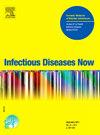Delta and Omicron SARS-CoV-2 pneumonia: Comparison of clinical and radiological features
IF 2.9
4区 医学
Q2 INFECTIOUS DISEASES
引用次数: 0
Abstract
Background
Computed tomography (CT) is a critical tool for the diagnosis of pneumonia caused by SARS-CoV-2. The Delta and Omicron variants show distinct clinical features, but the radiological differences between pneumonia caused by these variants have not been extensively studied in patients with oxygen-dependent pneumonia.
Objective
To compare the radiological and clinical features of pneumonia in patients hospitalized with oxygen-dependent SARS-CoV-2 infection caused by the Delta and Omicron variants.
Methods
We performed a retrospective single-center study, including patients hospitalized with oxygen-dependent SARS-CoV-2 pneumonia between October 2021 and February 2022. Clinical and radiological data were collected and compared between patients infected with the Delta variant and those with the Omicron variant. CT scans were reviewed by a radiologist and a pulmonologist blinded to clinical and variant information.
Results
A total of 135 patients with the Delta variant and 48 with the Omicron variant were included. Patients infected with Omicron were older (median age 75 years [68–83.2] vs 69 years [62–77.5], p = 0.004), more immunocompromised (52 % vs. 25 %, p < 0.001), and had higher vaccination rates (73 % vs. 51 %, p = 0.009). Radiologically, ground-glass opacities were present in 95 % of patients. There were no significant differences in the degree of lung involvement, type of lesions and their predominance. Unilateral lung involvement was more common in Omicron-infected patients (8.3 % vs 0.74 %, p = 0.02).
Conclusion
While Omicron oxygen-dependent pneumonia occurred in older and more comorbid patients, its clinical and radiological features were largely indistinguishable from those caused by the Delta variant, except for a higher rate of unilateral lung involvement.
求助全文
约1分钟内获得全文
求助全文
来源期刊

Infectious diseases now
Medicine-Infectious Diseases
CiteScore
7.10
自引率
2.90%
发文量
116
审稿时长
40 days
 求助内容:
求助内容: 应助结果提醒方式:
应助结果提醒方式:


